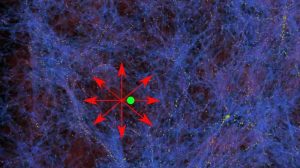
There is a not-subtle difference between a theory that explains what we see and a believable theory that explains what we see.
Right now, if we go outside and look at the expansion rate of our universe based on our observations of the early universe and based on our observations of the modern universe, we will get two somewhat different values, with our modern universe appearing to expand faster than it should. This discrepancy is called the Hubble Tension. A new paper in the Monthly Notices of the Royal Astronomical Society, led by Sergij Mazurenko, has tried to explain this as the result of our galaxy and the local group being precisely located within a void surrounded by a higher-density region of the universe that is just beyond what we’re able to see. In this theory, we live in a special place in the universe that allows us to see everything around us moving away just that much faster because of the pull of unseen mass.
And it is that special place requirement that makes this theory not that great. As a first principle, cosmologists posit that we live in neither a special time nor a special place and that what we see here should be the same everywhere. While we do acknowledge that we live in a fairly nice several billion-year span of time where there is just the right stuff forming just the right kinds of stars, that level of “special” we can live with. Saying we are precisely in the middle of some unseen void… that takes it a step too far for many. But the theory works.
So the real question needs to be is there a better theory? Sometimes, explaining our universe and knowing we got it right just feels harder than it should be.
